Trading 212 Pies Explained: How Automated Portfolio Investing Actually Works


When I first discovered Trading 212 Pies, I was skeptical about how they could offer sophisticated portfolio management without charging fees. After extensive testing and research, I've found that their "semi-robo" approach genuinely bridges the gap between expensive robo-advisors and purely DIY investing, though it's not without limitations.
Trading 212 Pies lets you build automated investment portfolios with zero commission fees and just £1 minimum investments. With over 4.5 million funded accounts globally, the platform has proven particularly popular among UK and EU investors seeking cost-effective diversification without the hefty fees charged by traditional robo-advisors.
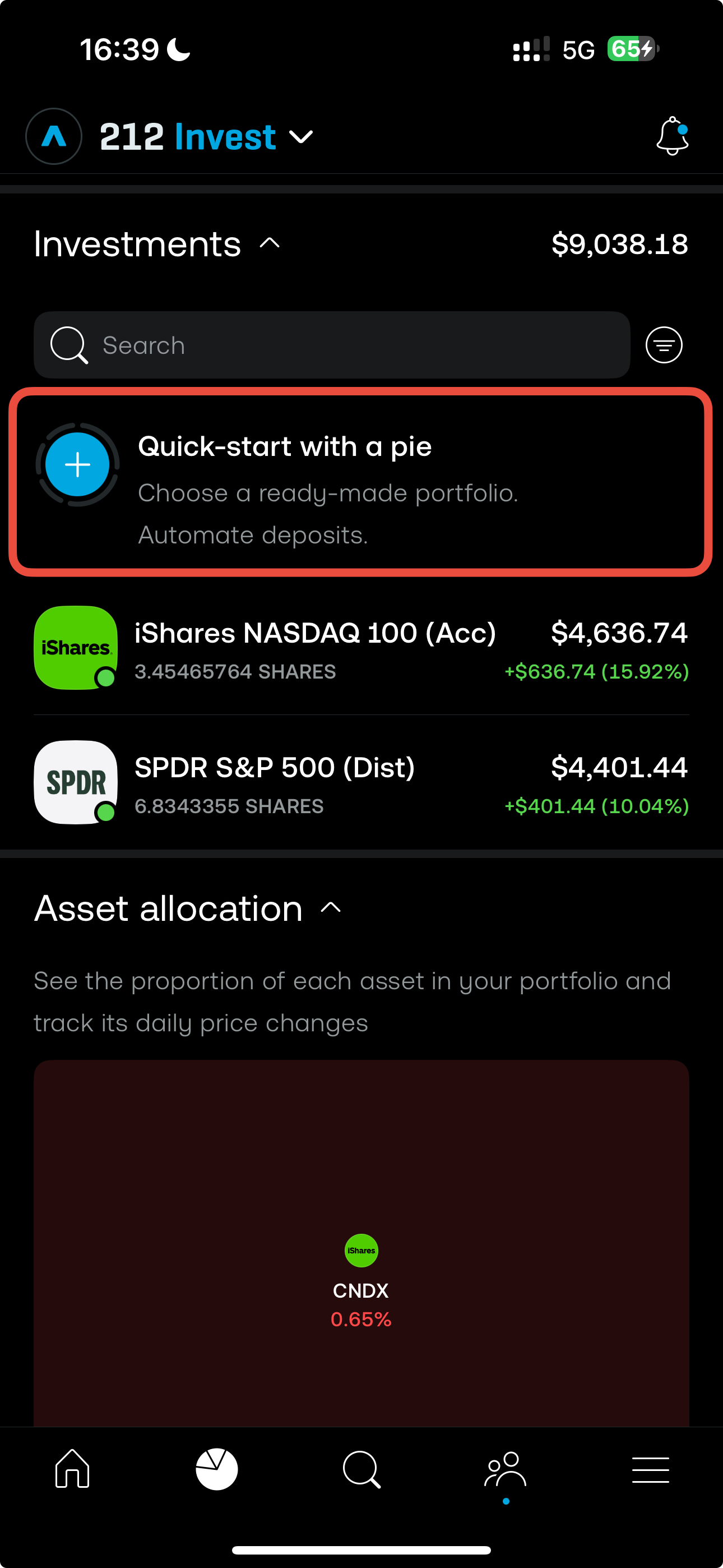
What Are Trading 212 Pies?
Think of Trading 212 Pies as customizable investment containers that automatically maintain your desired portfolio allocation. Each "pie" can hold up to 50 different stocks and ETFs, with you setting the target percentage for each holding. When you invest new money, the platform automatically distributes it according to these percentages, maintaining your chosen allocation without any manual effort.
The system works through fractional shares, meaning you can own tiny portions of expensive stocks like Apple or Tesla. This makes it possible to create a properly diversified portfolio even with small amounts of money - something that would be impossible with traditional whole-share investing.
What sets Trading 212 apart from pure robo-advisors is the control factor. You choose exactly which investments go into your pie, rather than being assigned a generic risk-based portfolio. Yet you still get the automation benefits of scheduled investing and automatic rebalancing.
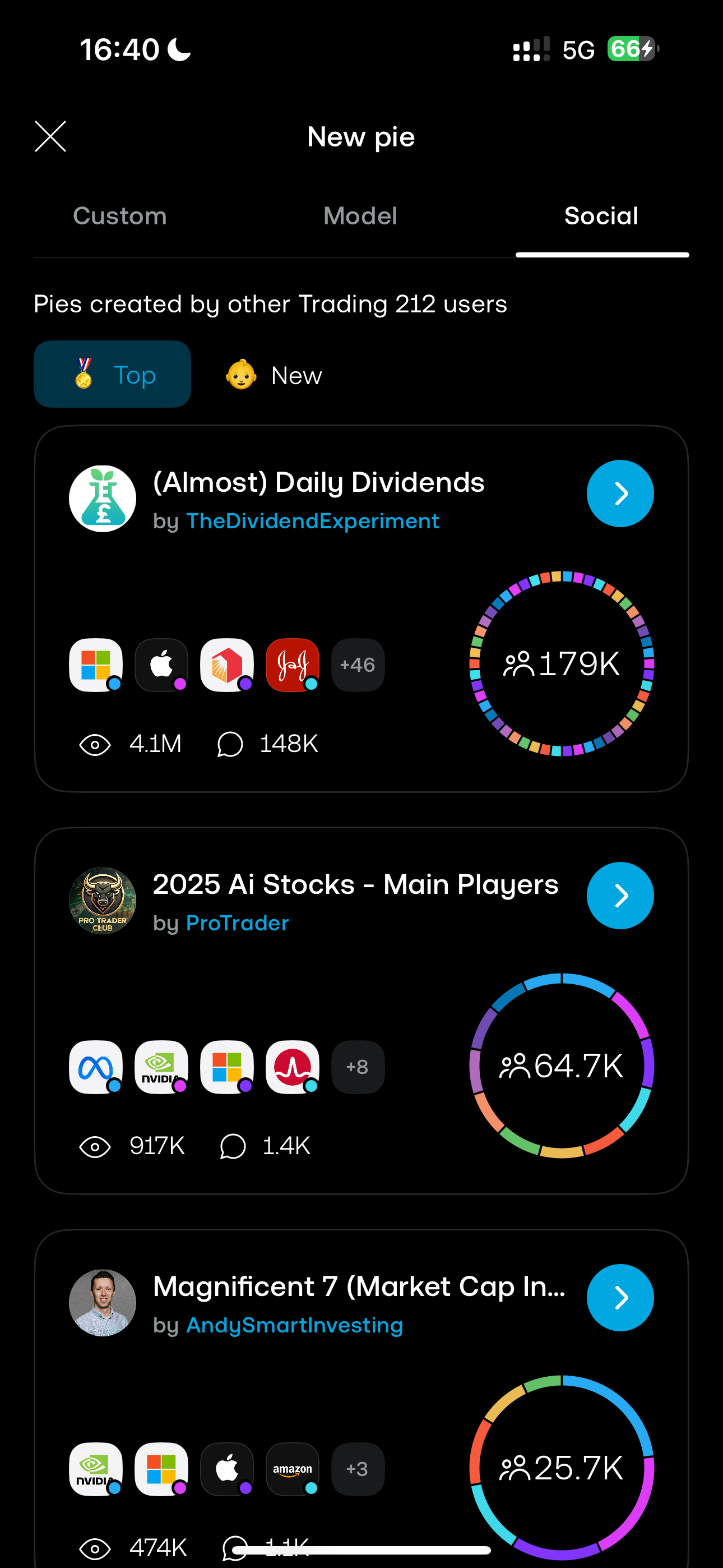
How Trading 212 Pies Actually Work
Creating a pie starts with selecting your investments from Trading 212's universe of over 13,000 stocks and ETFs. You can build from scratch, copy a ready-made "Model Pie" from professional managers like BlackRock, or browse community-created pies in their public library.
For each security you add, you set a target allocation percentage. The platform enforces that all percentages total exactly 100%, preventing mathematical errors that could throw off your strategy. Once your pie is configured, the AutoInvest feature handles the rest.
When you deposit money into a pie, Trading 212's algorithm automatically distributes it across your holdings to maintain target weights. If Apple makes up 10% of your pie but only represents 8% of your current value due to underperformance, new investments will favor Apple until it reaches the 10% target again.
The rebalancing process happens through a one-click manual system. Trading 212 calculates which positions are overweight or underweight, then automatically executes the necessary trades to restore your target allocation. For Model Pies, professional managers update allocations quarterly, with users receiving notifications to accept or reject these changes.
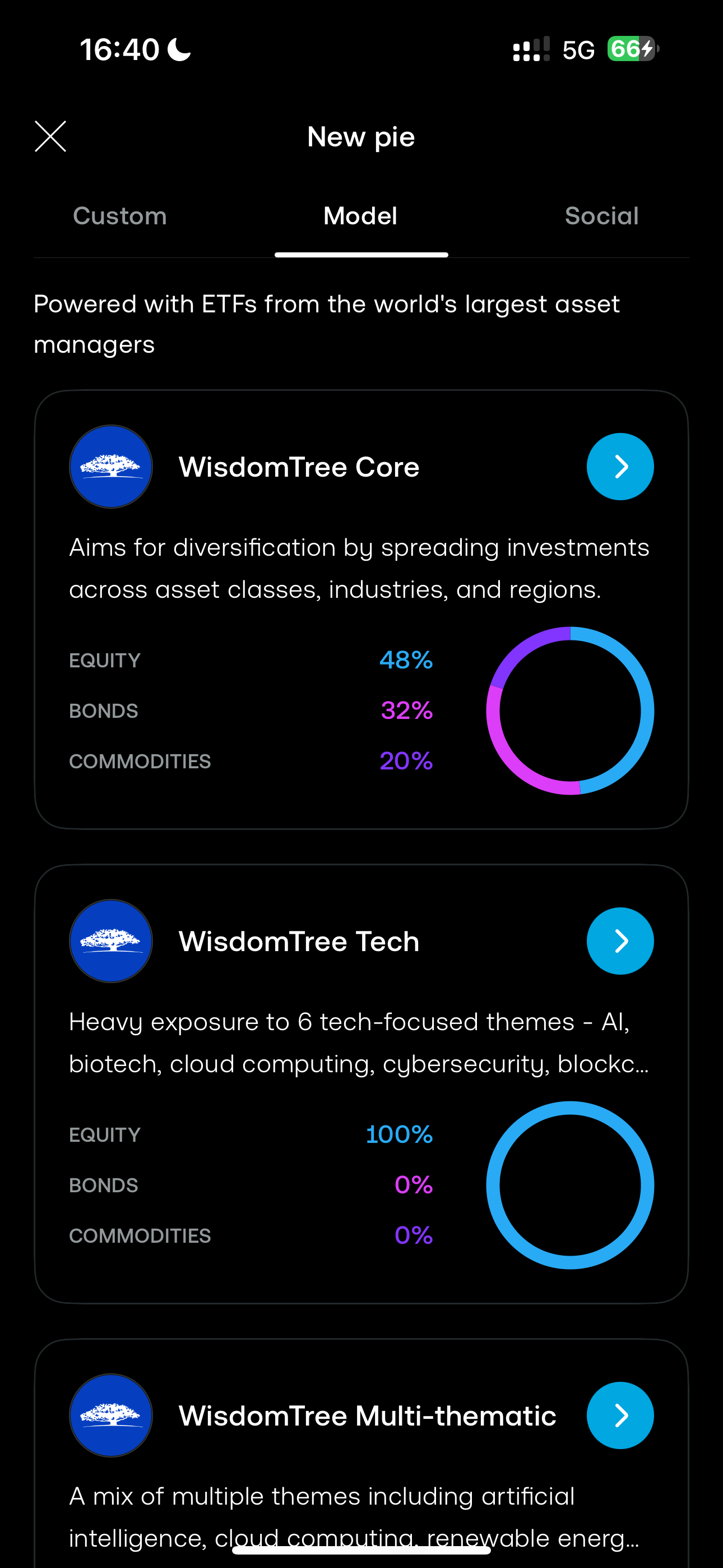
Current Features and 2024-2025 Enhancements
Trading 212 has significantly upgraded their Pies functionality over the past year. The most impactful change reduced minimum slice weights from 0.5% to 0.1%, effectively doubling your diversification potential within each pie. This means you can now hold positions as small as 0.1% in a single security, enabling more granular portfolio construction.
The platform now supports 24/5 trading for individual stocks, though pie investments still execute during regular market hours only. This limitation frequently appears in user feedback as a requested enhancement, particularly for dollar-cost averaging strategies that could benefit from extended execution windows.
Performance tracking received major upgrades with Money-Weighted Return Rate (MWRR) calculations, which provide more accurate returns by accounting for the timing of your contributions. You can now set investment goals, track progress visually, and export detailed performance data via CSV files.
Currency support expanded to 13 different currencies across UK, US, German, French, Spanish, and Dutch markets. This broad market access enables truly international portfolio construction, though currency conversion fees apply when rebalancing across different base currencies.
Ready-Made vs Custom Pies: Which Should You Choose?
Trading 212 offers two main pie construction approaches, each serving different investor needs and experience levels.
Ready-Made Model Pies come from professional asset managers including BlackRock, WisdomTree, and other institutional providers. These range from simple broad-market index strategies to complex thematic portfolios focusing on areas like clean energy or emerging markets. The obvious advantage is professional management - these firms have teams of analysts and portfolio managers making allocation decisions.
However, Model Pies typically carry additional management fees beyond Trading 212's free platform. WisdomTree pies, for example, charge around 0.6% annually on top of underlying ETF expense ratios. While still cheaper than traditional robo-advisors, these fees can add up over time.
Custom Pies put you in complete control of investment selection and allocation. You choose every security, set every percentage, and decide when to rebalance. This approach works well if you have strong investment knowledge or want to implement specific strategies not available in pre-made options.
The learning curve is steeper with custom pies, and you bear full responsibility for diversification and risk management. There's no professional oversight to catch potential issues like concentration risk or poor correlation patterns between your chosen investments.
I generally recommend starting with ready-made pies if you're newer to investing, then gradually experimenting with custom pies as your knowledge grows. You can run multiple pies simultaneously, making it easy to test different approaches with small amounts of money.
Trading 212 Pies Fees and Costs Breakdown
One of Trading 212's strongest selling points is their zero-commission structure, but "free" requires some qualification when you examine the complete cost picture.
What's Actually Free:
- Stock and ETF trades within pies
- Account maintenance and custody
- Pie creation and management tools
- Rebalancing transactions
- Dividend reinvestment
- ISA wrapper for UK investors
Where Costs Apply:
- 0.15% FX conversion fee on foreign currency trades
- 0.7% fee on card/e-wallet deposits over £2,000 total
- Government taxes: 0.5% UK Stamp Duty on LSE shares
- US FINRA fees on American stock trades
- Model Pie management fees (varies by provider)
The FX conversion fee is the most significant cost for diversified international portfolios. If your pie contains UK, US, and European stocks, rebalancing triggers currency conversions at 0.15% each way. For frequent rebalancers, this can add up over time.
Investment Universe: What Can You Actually Buy?
Trading 212 Pies support over 13,000 securities across major global markets, though this universe has some notable limitations compared to full-service brokers.
Available Asset Classes:
- Individual stocks from UK, US, German, French, Spanish, and Dutch exchanges
- 1,800+ ETFs covering equities, bonds, commodities, and REITs
- Fractional shares enabling precise allocation
- Dividend-paying securities with automatic reinvestment options
What's Missing:
- Direct cryptocurrency exposure (though crypto ETFs are available)
- Individual bonds (bond ETFs only)
- Options, futures, or other derivatives
- CFDs (available separately on Trading 212 but not in pies)
- Some smaller international markets
The ETF selection, while substantial, is somewhat limited compared to platforms like Interactive Brokers or Saxo Bank. You'll find all major broad-market index funds and most popular sector/thematic ETFs, but some niche or newer offerings might not be available.
Market access quality is generally strong, with real-time pricing and efficient execution. The recent addition of 24/5 trading for individual stocks adds flexibility, though this extended access doesn't currently apply to automated pie investments.
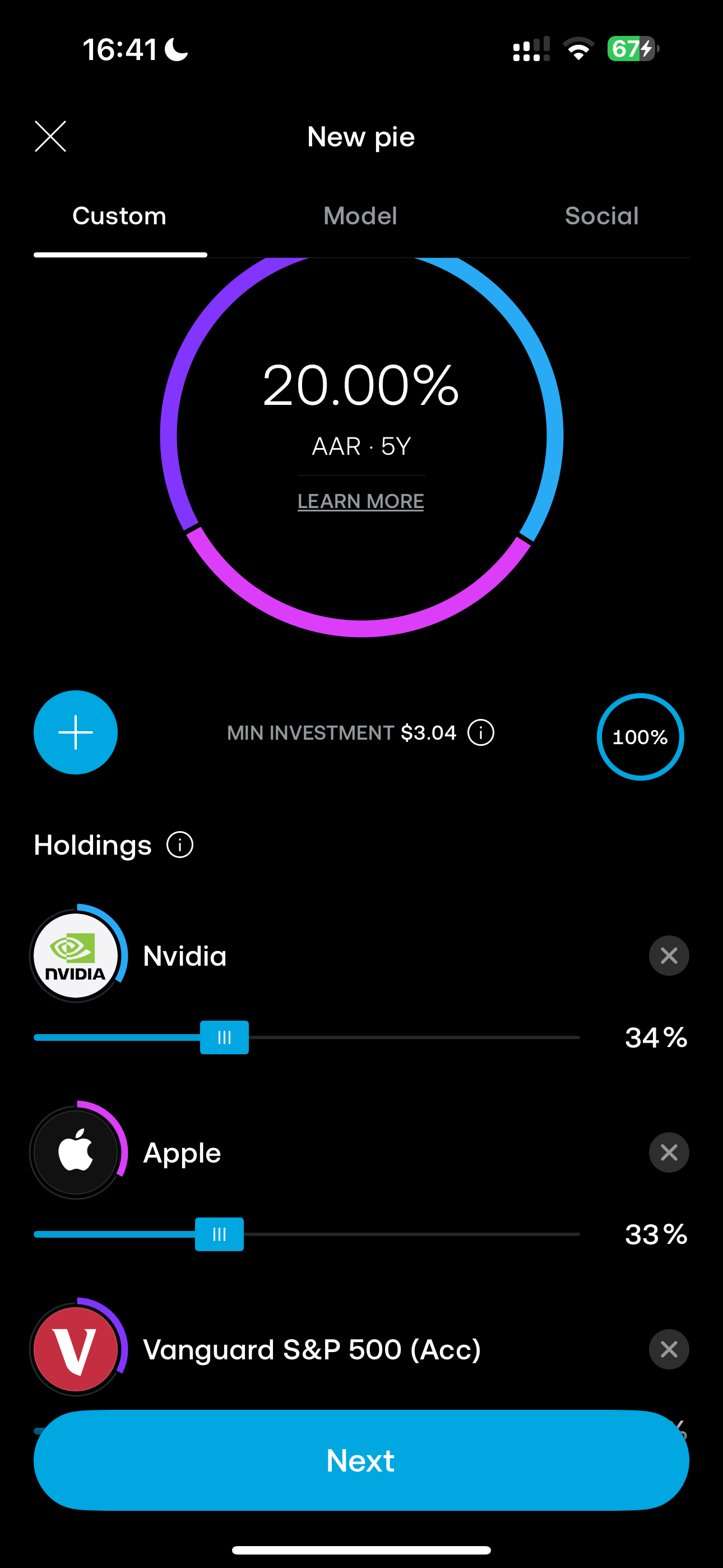
AutoInvest and Rebalancing: The Automation Advantage
The AutoInvest feature transforms Trading 212 Pies from a simple portfolio tool into a genuine wealth-building system. You can schedule recurring investments daily, weekly, monthly, or at custom intervals, with the platform automatically distributing funds according to your target allocation.
This creates a powerful dollar-cost averaging effect, smoothing out market volatility over time. When markets are down, your fixed investment amount buys more shares. When markets rise, you buy fewer shares at higher prices. Over long periods, this typically reduces your average cost per share compared to lump-sum investing.
Smart Allocation Logic
The platform prioritizes underweight positions when new money arrives, automatically helping maintain your target allocation without forced rebalancing. If your technology allocation has grown from 20% to 25% due to strong performance, new investments will favor other holdings until the 20% target is restored.
Manual Rebalancing
One-click rebalancing is available whenever you want to reset allocations to target percentages. The platform calculates required trades automatically, selling overweight positions and buying underweight ones in a single transaction batch. This process typically completes within minutes during market hours.
Rebalancing Frequency
Unlike some robo-advisors that rebalance monthly or quarterly whether needed or not, Trading 212 gives you complete control over timing. Some investors rebalance monthly, others quarterly, and some only when allocations drift beyond acceptable ranges (like 5% from target).

Performance Tracking and Analytics
Trading 212's recent analytics upgrades bring institutional-quality performance measurement to retail investors. The Money-Weighted Return Rate (MWRR) calculation is particularly valuable, as it accounts for the timing of your contributions rather than just portfolio price changes.
Key Performance Metrics:
- Total return (capital gains plus dividends)
- Money-weighted returns accounting for contribution timing
- Individual security performance within each pie
- Dividend tracking and reinvestment history
- Goal-setting tools with progress visualization
- Comparison to benchmark indices (limited selection)
Performance Reporting Limitations
While the built-in analytics are solid, serious investors often supplement with third-party tools like Portfolio Visualizer or Morningstar for deeper analysis. Trading 212's benchmark comparison options are limited, and there's no automatic tax reporting for complex portfolios.
The CSV export functionality helps with external analysis and record-keeping, particularly important for investors holding multiple pies or managing taxable accounts alongside ISAs.
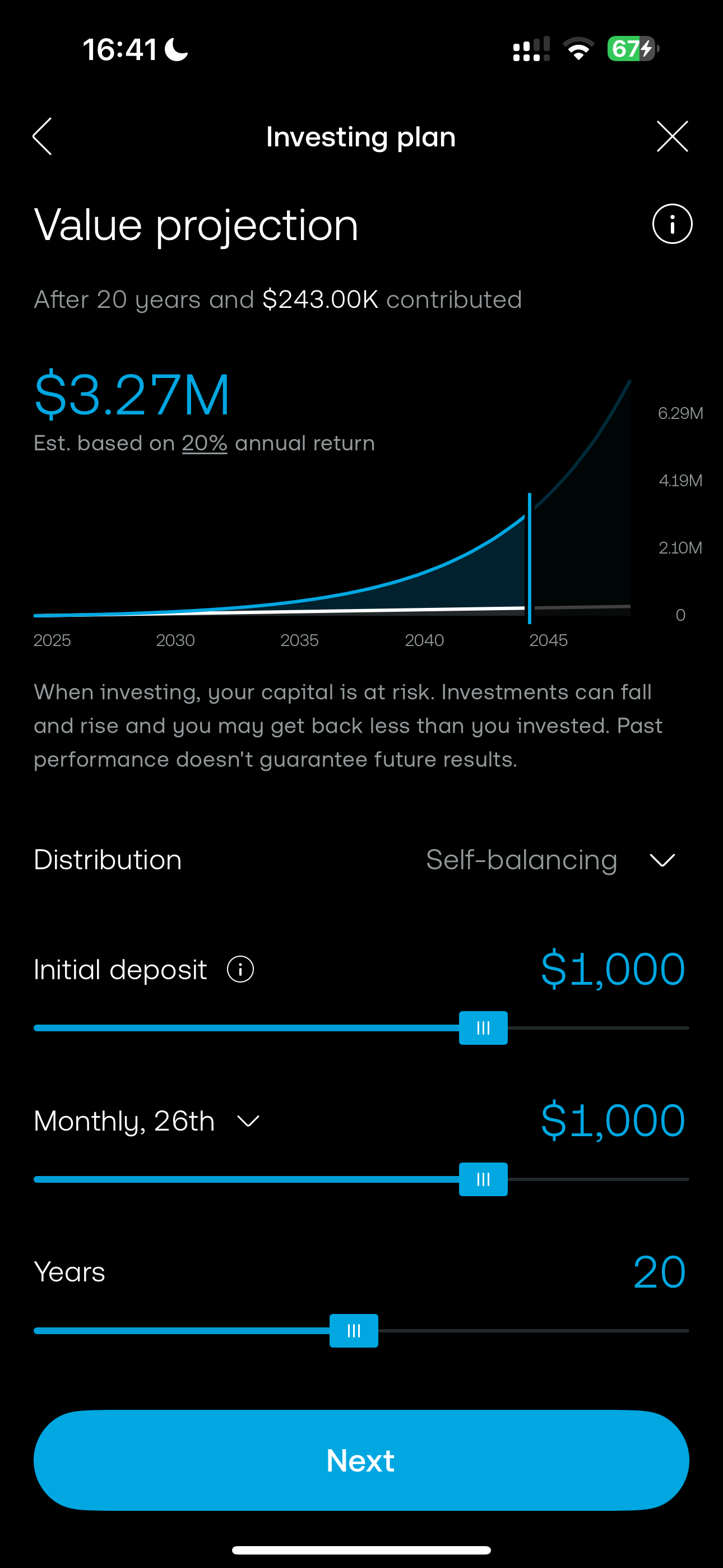
User Experience: Mobile-First Design
Trading 212 built their platform with mobile users in mind, and it shows in both the smartphone apps and web interface. The visual pie charts make portfolio allocation immediately clear, even to investment beginners.
What Users Love:
- Clean, intuitive interface requiring minimal learning curve
- Visual pie representations making allocation easy to understand
- Quick pie creation and modification process
- Smooth money deposit and withdrawal flows
- Comprehensive search and filtering for security selection
Common Complaints:
- Occasional display bugs affecting performance calculations
- Limited advanced charting compared to dedicated trading platforms
Setup typically takes one business day including identity verification, though some users report delays during busy periods. The £1 minimum deposit removes barriers to getting started, though building meaningful diversification requires larger amounts.
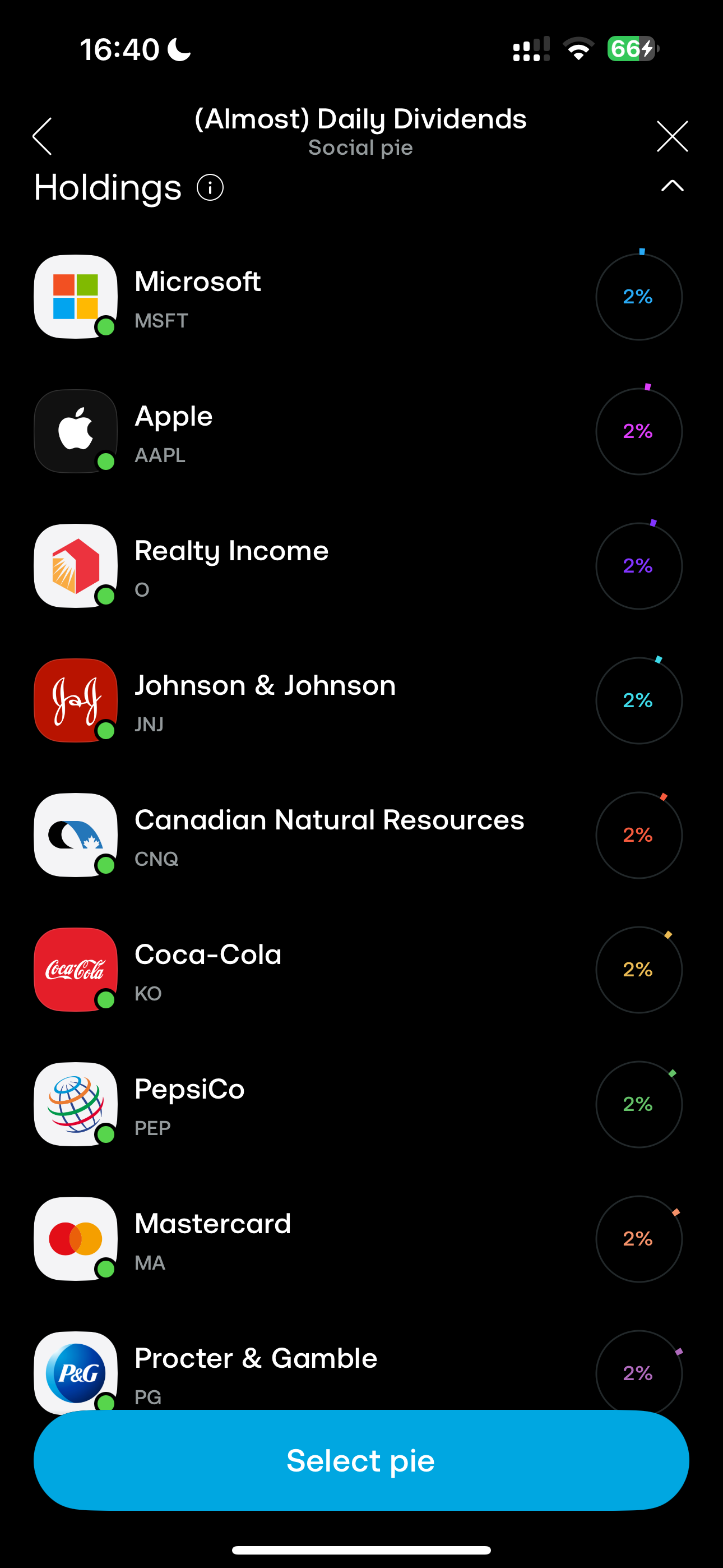
Safety and Regulation: Is Your Money Protected?
Trading 212's regulatory framework provides strong investor protection across multiple jurisdictions. UK operations hold FCA authorization (Registration 609146), while EU services operate under CySEC licensing (License 398/21), ensuring compliance with MiFID II requirements.
Client Fund Protection
Your money is held separately from Trading 212's corporate funds through segregated accounts with major institutional partners including JPMorgan Chase and Barclays. This segregation means your investments remain protected even in the unlikely event of Trading 212's business failure.
Insurance Coverage
Beyond regulatory protection, Trading 212 maintains additional Lloyd's of London insurance up to €1 million, providing an extra safety layer for client assets. Combined with FSCS/ICF coverage, this creates comprehensive protection for most retail investors.
ISA Tax Advantages
UK investors benefit from Stocks & Shares ISA eligibility, allowing up to £20,000 annual contributions with tax-free growth and dividends. This tax wrapper significantly enhances long-term returns for UK taxpayers, particularly higher-rate payers.
Trading 212 has maintained good regulatory standing throughout 2024-2025, with no significant sanctions or compliance issues. Recent enhancements include obtaining a CySEC cryptocurrency license and strengthened risk management procedures.
Pros and Cons: The Complete Picture
After extensive testing and research, here's my balanced assessment of Trading 212 Pies' strengths and weaknesses:
Major Advantages:
- Zero commission fees on stocks and ETFs
- £1 minimum investment enabling easy diversification
- Fractional shares allowing precise allocation
- Strong regulatory protection with FSCS/ICF coverage
- ISA wrapper providing tax advantages for UK investors
- Intuitive interface suitable for beginners
- AutoInvest automation reducing behavioral investing mistakes
- Access to professional Model Pies from major asset managers
Significant Limitations:
- No professional portfolio management or financial advice
- Technical issues including app crashes and performance bugs
- Inconsistent customer support quality
- 50-security limit per pie constraining complex strategies
- Limited benchmark comparison options
- Tax complexity for pies with numerous holdings
- Fractional shares cannot transfer to other brokers
Who Should Consider Trading 212 Pies:
- Cost-conscious investors prioritizing low fees
- Beginners wanting automation without complexity
- UK investors seeking ISA-eligible automated investing
- DIY investors comfortable with self-directed strategies
- Those wanting to test robo-advisor concepts with small amounts
Who Should Look Elsewhere:
- Investors wanting professional financial advice
- Those requiring complex portfolio strategies beyond 50 securities
- Users needing guaranteed uptime and premium support
- Investors planning frequent broker transfers (fractional share limitations)
Getting Started: Step-by-Step Setup Guide
Setting up your first Trading 212 Pie is straightforward, though some preparation helps ensure success:
1. Account Opening (1 business days)
Download the Trading 212 app or visit their website to begin registration. You'll need government-issued ID, proof of address, and basic financial information. The identity verification process typically completes within 24 hours.
2. Choose Your Account Type
UK investors should strongly consider the Stocks & Shares ISA for tax advantages. EU investors use the standard Invest account. You can open both types if desired, though annual ISA contributions are capped at £20,000.
3. Fund Your Account
Bank transfers are free and typically clear within 1-2 business days. Card and e-wallet deposits are instant but carry 0.7% fees above £2,000 total deposits. Start with a small amount while learning the platform.
4. Create Your First Pie
New users often benefit from starting with a ready-made Model Pie to understand the mechanics before creating custom portfolios. Browse options from BlackRock, WisdomTree, and community creators to find strategies matching your risk tolerance.
5. Set Up AutoInvest
Configure recurring investments matching your budget and investment timeline. Monthly contributions work well for most investors, though you can adjust frequency based on your cash flow patterns.
Final Verdict: Is Trading 212 Pies Right for You?
After extensive testing and analysis, Trading 212 Pies successfully delivers on its core promise: sophisticated portfolio automation without the fees charged by traditional robo-advisors. The platform democratizes investment strategies previously available only to wealthy clients, making diversification accessible to anyone with £1 to invest.
The zero-commission structure, combined with strong regulatory protection and tax-efficient ISA access for UK investors, creates genuine value for cost-conscious investors. Recent feature enhancements demonstrate Trading 212's commitment to product development and user satisfaction.
However, this cost advantage comes with trade-offs. You won't get professional financial advice, guaranteed uptime, or premium customer support. Technical issues and platform limitations may frustrate some users, particularly those managing complex portfolios or requiring frequent customer service interaction.
Trading 212 Pies work best for:
- DIY investors comfortable making their own investment decisions
- Cost-conscious savers wanting automated execution without advisory fees
- UK investors seeking ISA-eligible portfolio automation
- Beginners wanting to learn portfolio management with low barriers to entry
- Those testing robo-advisor concepts before committing larger amounts
Consider alternatives if you:
- Want professional financial advice and portfolio management
- Need guaranteed platform reliability and premium support
- Plan complex strategies requiring more than 50 securities per portfolio
- Frequently transfer assets between brokers (fractional share limitations)
- Prefer completely hands-off investing without any decision-making
For the right investor, Trading 212 Pies represent excellent value in the automated investing space. The combination of zero fees, flexible portfolio construction, and regulatory protection creates a compelling proposition that's particularly attractive in today's high-fee environment.
Just remember that "free" platform access doesn't eliminate the need for investment knowledge. While Trading 212 handles the execution, you're still responsible for making sound investment decisions that align with your risk tolerance and financial goals.
Current New Customer Bonus
Trading 212 currently offers new customers the opportunity to receive a free fractional share worth up to €100/£100 when you make your first deposit. This bonus can provide a nice boost to your initial pie investments, though terms and conditions apply including minimum deposit requirements and holding periods.
Frequently Asked Questions
How much does it cost to use Trading 212 Pies?
Trading 212 Pies are free to create and manage, with zero commission on stock and ETF trades. The main cost is a 0.15% FX conversion fee when trading foreign currencies. Model Pies may carry additional management fees from their providers (typically 0.4-0.6% annually), but basic pie functionality remains free.
What's the minimum investment for Trading 212 Pies?
You can start investing in Trading 212 Pies with just £1 minimum deposit. Each individual security within a pie can be allocated as little as 0.1% of your portfolio, though practical diversification typically requires larger amounts.
Can I use Trading 212 Pies in an ISA?
Yes, Trading 212 Pies are available in Stocks & Shares ISAs for UK investors, allowing up to £20,000 annual contributions with tax-free growth and dividends. This makes them particularly attractive for UK taxpayers seeking automated, tax-efficient investing.
How many stocks can I include in a single pie?
Each Trading 212 Pie can hold up to 50 different securities (stocks and ETFs). This limit constrains very complex strategies but provides sufficient diversification for most retail investors. You can create multiple pies if you need broader diversification.
Do Trading 212 Pies automatically rebalance?
Trading 212 Pies use "smart allocation" for new investments, automatically favoring underweight positions to maintain target allocation. However, full rebalancing requires manual activation through a one-click process. There's no automatic scheduled rebalancing feature currently.
Can I copy other people's pie strategies?
Yes, Trading 212 offers a public Pie Library where users share their strategies. You can browse, analyze, and copy community-created pies, though you should always research holdings before investing. Ready-made Model Pies from professional managers are also available.
What happens to my fractional shares if I leave Trading 212?
Fractional shares cannot transfer to other brokers and must be sold when closing your Trading 212 account. This creates potential exit costs and tax implications, particularly for taxable accounts with accumulated gains. Plan accordingly when choosing your broker.
Looking for personalized broker recommendations based on your specific needs? Try our Broker Match tool to find the best platform for your investment goals.
For more detailed Trading 212 analysis, read our comprehensive Trading 212 review covering all platform features.
Disclaimer: When investing, your capital is at risk, and you may get back less than invested. Past performance doesn’t guarantee future results.



